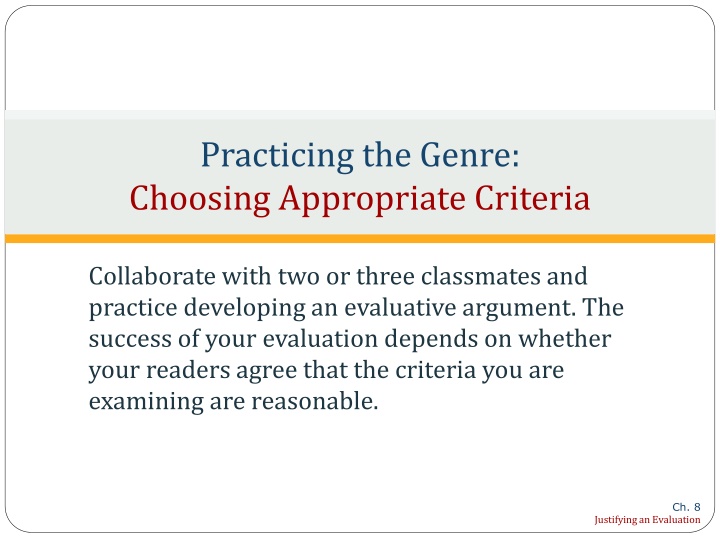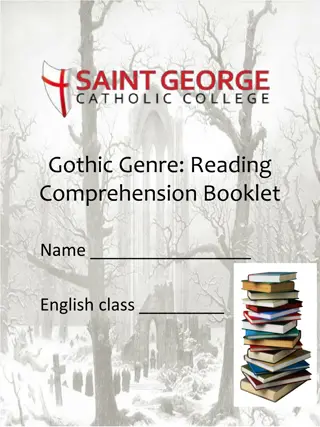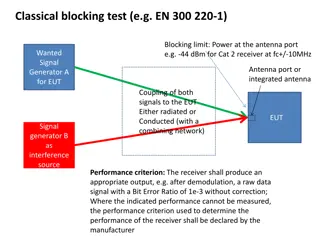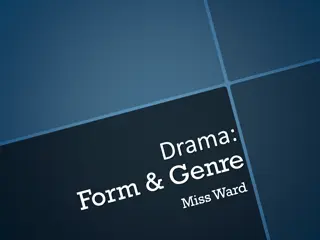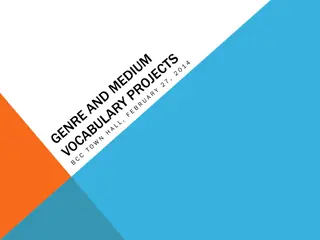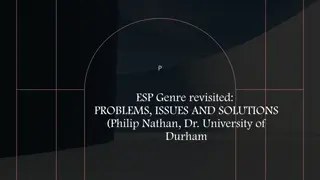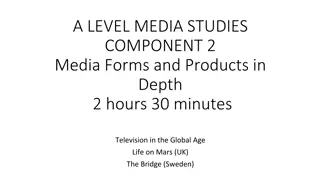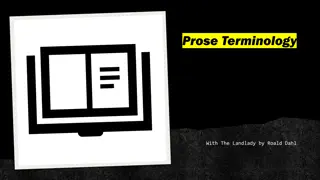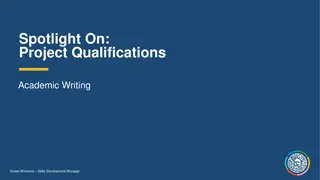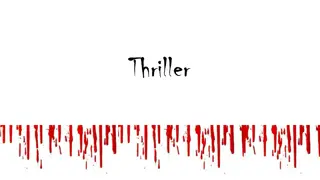Practicing the Genre: Choosing Appropriate Criteria
Collaborate with classmates to evaluate a film by identifying criteria and discussing expectations. Analyze sample evaluations to understand writers' purposes and audiences.
Download Presentation

Please find below an Image/Link to download the presentation.
The content on the website is provided AS IS for your information and personal use only. It may not be sold, licensed, or shared on other websites without obtaining consent from the author.If you encounter any issues during the download, it is possible that the publisher has removed the file from their server.
You are allowed to download the files provided on this website for personal or commercial use, subject to the condition that they are used lawfully. All files are the property of their respective owners.
The content on the website is provided AS IS for your information and personal use only. It may not be sold, licensed, or shared on other websites without obtaining consent from the author.
E N D
Presentation Transcript
Practicing the Genre: Choosing Appropriate Criteria Collaborate with two or three classmates and practice developing an evaluative argument. The success of your evaluation depends on whether your readers agree that the criteria you are examining are reasonable. Ch. 8 Justifying an Evaluation
Part One Choose a film and take turns reviewing it: Identify the type of film you think it was (for example, romantic comedy, science fiction, action, etc.) Say one thing you expect from films of this type. Say whether this particular film surpassed, met, or fell short of your expectations for this type of film and why.
Part Two Discuss what you learned: What did you learn about criteria, or standards, appropriate for evaluating the film you chose? Discuss the similarities/differences between yours and your classmates expectations. Your expectations represent your criteria for that particular type of film; identify a must have for that type. Think about how the context for your review the purpose, audience, and medium affects the criteria you use. If you were to make your evaluation public, would you use the same criteria you used in your group? What would you assume about your audience, and how could you justify the criteria you think are most important?
Guide to Reading: Analyzing Evaluations Read the selections in this chapter and analyze how writers argue for an evaluation: William Akana argues that Scott Pilgrim vs. the World is a hell of a ride (pp. 341-46). Emily Nussbaum tries to persuade readers that Game of Thrones is an engrossing series well worth watching, despite its gruesome violence (pp. 346-49). Malcolm Gladwell argues that the U.S. News college rankings uses a flawed ranking system (pp. 352-55). Sherry Turkle tries to convince readers that texting is no substitute for face-to-face relationships (pp. 358-60).
Analyzing Evaluations: Determine the writer s purpose. What seems to be the writer s main purpose? to influence readers judgments and possibly their actions? to inspire readers to think critically about which criteria are appropriate for judging subjects of this kind? to get readers to look at the subjects in a new way?
Analyzing Evaluations: Determine the writer s audience. What does the writer assume about the audience? that readers will accept the writer s judgment? that they will use the review to make their own independent, informed judgment? that they already made up their minds and want to see what others think? that they will have serious objections to the writer s argument?
Analyzing Evaluations: Assess the genre s basic features. A Well-Presented Subject A Well-Supported Judgment An Effective Response to Objections and Alternative Judgments A Clear, Logical Organization
A Well-Presented Subject Read first to identify the subject of the review. The subject is often named/described in the title or opening paragraphs. Writers will classify their subject according to genre. Here is an example from student writer William Akana. Notice the genre, blue bold, and subgenres, red with an underscore: From start to finish, Scott Pilgrim vs. the World delivers intense action in a hilarious slacker movie that also somehow reimagines romantic comedy. (par. 1) Classifying by genre/subgenre helps readers determine whether the writer is applying appropriate criteria.
A Well-Supported Judgment What is the writer s judgment? How does the reviewer compare the subject with other things in the same genre? Writers usually announce their judgments in a thesis statement. Examine the thesis to see whether the writer asserts an overall judgment. Note the features of the subject that are being praised or criticized and the reasons supporting the judgment. Are the reasons based on criteria expected of this type/genre? Consider the types of evidence provided (examples, visuals, etc.) and whether the writer cites sources by quoting, paraphrasing, or summarizing. Notice whether the reviewer uses comparison and contrast.
An Effective Response to Objections and Alternative Judgments How does the writer respond to objections or alternative judgments posed by readers? Writers may concede (accept) or refute (argue against) alternatives. A basic concession (transition in pink): Of course, _______ is an important factor. Granted, _______ must be taken into consideration A basic refutation (transition in yellow): Although _______, I think _______. X says _______, but I think _______ because _______.
A Clear, Logical Organization Read to see if the reviewer provides cues to help readers follow the logic of the argument. Are the reasons forecast in the thesis or opening? Where are they brought up again later in the essay? Notice how the writer uses logical transitions, such as because (to introduce reasons) and another (to indicate reasons in a list). How does the writer integrate visuals (film stills, cartoons, screen shots, etc.) into the text?
Guide to Writing: The Writing Assignment Choose a subject and develop a judgment about it. Write an essay that evaluates this subject, providing reasons for your judgment that are based on familiar criteria/standards. Include examples that support your reasons.
Starting Points: Justifying an Evaluation Basic Feature Ask Yourself . . . How do I come up with a subject to write about? Take a Look at . . . Consider possible topics: Offering a mixed judgment. (p. 352) Consider possible topics: Evaluating a text. (p. 358) Consider possible topics: Evaluating a technology- related subject. (p. 363) Choose a subject to evaluate. (p. 367) Test Your Choice: Choosing a Subject (pp. 367 68) Assess your subject and consider how to present it to your readers. (pp. 368 69) Determine the writer s purpose and audience. (p. 337) Assess the genre s basic features: A well-presented subject. (p. 338) A Well-Presented Subject: Providing Information (pp. 349 50) A Well-Presented Subject: Introducing a Complicated Subject (p. 356) A Well-Presented Subject: Identifying the Subject (p. 361) Assess your subject and consider how to present it to your readers. (pp. 368 69) A Well- Presented Subject How can I present my subject clearly and convincingly?
Starting Points: Justifying an Evaluation Basic Feature Ask Yourself . . . How do I come up with a thesis statement? Take a Look at . . . Assess the genre s basic features: A well-supported judgment. (pp. 338 39) Formulate a working thesis stating your overall judgment. (pp. 369 70) How do I construct an argument supporting my judgment? Assess the genre s basic features: A well-supported judgment. (pp. 338 39) A Well-Supported Judgment: Basing a Judgment on Criteria (pp. 350 51) A Well-Supported Judgment: Defining Criteria (pp. 356 57) A Well-Supported Judgment: Providing Supporting Evidence (p. 362) Develop the reasons and evidence supporting your judgment. (pp. 370 71) Research your evaluation. (p. 371) A Well- Supported Judgment
Starting Points: Justifying an Evaluation Basic Feature Ask Yourself . . . How do I respond to possible objections and alternative judgments? Take a Look at . . . Assess the genre s basic features: An effective response to objections and alternative judgments. (pp. 339 40) An Effective Response to Objections and Alternative Judgments: Conceding and Refuting Alternative Judgments (p. 351) An Effective Response to Objections and Alternative Judgments: Singling Out a Comment for Response (p. 357) An Effective Response to Objections and Alternative Judgments: Appealing to Shared Values (pp. 362 63) Respond to a likely objection or alternative judgment. (pp. 371 73) An Effective Response to Objections and Alternative Judgments
Starting Points: Justifying an Evaluation Basic Feature Ask Yourself . . . How can I help my readers follow my argument? Take a Look at . . . Assess the genre s basic features: A clear, logical organization. (pp. 340 41) A Clear, Logical Organization: Cueing Readers (p. 352) A Clear, Logical Organization: Using Comparison and Contrast (pp. 357 58) A Clear, Logical Organization: Creating Coherence (p. 363) Organize your draft to appeal to your readers. (p. 373) A Clear, Logical Organization
Guide to Writing: Writing a Draft: Invention, Research, Planning, and Composing The following activities will help you choose a subject for which you can compose an evaluative argument. You can use your responses to the following activities in your rough draft.
Choose a subject to evaluate. The subject you choose must be: one that has strengths/weaknesses you can write about; one that you can view and review (a location you can visit, a printed text, etc.); one evaluated according to criteria/standards of judgment that are familiar to you and your readers. You can choose subjects related to school, your community, or work.
Test Your Choice Choosing a Subject Make your choice and ask yourself the following questions: Do I know enough about the subject, or can I learn enough in the time I have? Do I already have a judgment about this subject? Do I know what criteria/standards my readers are likely to use? Would I use the same criteria for something of this type? Get together with two or three students and take turns presenting your subject and listening to others descriptions.
Assess your subject and consider how to present it to your readers. Once you have chosen a subject, consider how to frame/reframe it to make readers open to your evaluation; what you think of your subject; what your readers are likely to think of it.
Assess your subject and consider how to present it to your readers. WHAT DO I THINK? List those qualities of your SUBJECT that you like and dislike, or list its strengths and weaknesses or advantages and disadvantages. What makes X good/bad is _____, _____, and _____. Although X is stellar in _____ [ways], it falls short in _____ [other ways]. WHAT DO MY READERS THINK? Who are your READERS, and why will they be reading your review? Is the subject new or familiar to them? My readers are _____ and are probably reading my review to learn about the subject/to decide whether to see it, play it, or buy it. My readers will probably be familiar with the subject. They may be curious to know what I think because _____. What GENRE or kind of subject is it? X is a _____ [name genre or category of subject, such as romantic comedy or horror movie]. X is an innovative example of _____ [name category in which the subject belongs] that combines elements of _____ and _____. X is rather unconventional for a _____ [name category in which your subject belongs]. How might demographic factors such as the readers age, gender, cultural background, or work experience affect their judgment of the subject? Older/Younger readers are less/more likely to _____.
Assess your subject and consider how to present it to your readers. WHAT DO I THINK? What CRITERIA or standards of judgment do you usually use to evaluate things of this kind? I expect X to be _____ or _____. I dislike it when X is _____. WHAT DO MY READERS THINK? People who work in _____ or who are familiar with _____ may be more/less critical, or apply different standards to a subject like this one. What CRITERIA or standards of judgment do you expect your readers to use when evaluating subjects of this kind? What other EXAMPLES of the genre would they be familiar with? I expect readers to share my criteria. If they like/dislike Y, they are sure to like/dislike X. Judging X on the basis of _____ is likely to surprise readers because they probably are more familiar with _____ and _____. How does your subject COMPARE to other examples of the genre? Compared to Y, X has the best/worst _____ [name trait]. X is like Y in that both are/do/make _____, but X is more/less _____. Whereas Y can be faulted/praised for _____, X _____.
Formulate a working thesis stating your overall judgment. Contemplate ways to assert your thesis: You can state whether your subject is good or bad. You can compare it to something else in its genre. Evaluations can be mixed, depending on whether you re leaving a favorable or negative review.
Formulate a working thesis stating your overall judgment. HOW CAN I ASSERT A TENTATIVE OVERALL JUDGMENT? A good strategy is to begin by NAMING the subject and IDENTIFYING the kind of subject it is, and then using VALUETERMSto state your judgment of the subject s strengths and weaknesses: X is a brilliant embodiment of __________ [genre/category], especially notable for its superb __________ and thorough __________. Because I admire __________ [another artist s other work], I expected X to be __________. But I was disappointed/surprised by __________. X has many good qualities including __________ and __________; however, the pluses do not outweigh its one major drawback, namely that __________.
Develop the reasons and evidence supporting your judgment. HOW CAN I COME UP WITH REASONS AND EVIDENCE TO SUPPORT MY JUDGMENT? List the good and bad qualities of the subject. Begin by reviewing the CRITERIA and the VALUETERMSyou have already used to describe the good and bad qualities of the subject. These are the potential REASONS for your judgment. Try restating them using this basic sentence strategy, which is also illustrated by an example from student William Akana s film review: X is _______ [your overall judgment] because _______, _______, and _______. Example: Scott Pilgrim vs. the World can be appreciated and enjoyed by all audiences because of its inventive special effects, clever dialogue, and artistic cinematography and editing. (par. 2)
Develop the reasons and evidence supporting your judgment. HOW CAN I COME UP WITH REASONS AND EVIDENCE TO SUPPORT MY JUDGMENT? CONT D Write steadily for at least five minutes, developing your reasons. Ask yourself questions like these: Why are the characteristics I m pointing out for praise or criticism so important in judging my subject? Example: Akana singles out special effects, dialogue, cinematography and editing because of the particular kind of film Scott Pilgrim vs. the World is a hilarious slacker movie that also somehow reimagines romantic comedy (par. 1). How can I prove to readers that the value terms I m using to evaluate these characteristics are fair and accurate? Example: Akana analyzes the film s special effects and gives readers specific examples, including screen shots, to demonstrate that they are indeed inventive.
Develop the reasons and evidence supporting your judgment. HOW CAN I COME UP WITH REASONS AND EVIDENCE TO SUPPORT MY JUDGMENT? CONT D Make notes of the EVIDENCE you will use to support your judgment. Evidence you might use to support each reason may include the following: Examples Quotations from authorities Textual evidence (quotations, paraphrases, or summaries) Images Statistics Comparisons or contrasts You may already have some evidence you could use. If you lack evidence for any of your reasons, make a Research To Do note for later.
Research your evaluation. Determine what you need to find and search for articles and/or books on your topic via an all-purpose database, such as Academic OneFile (InfoTrac) or Academic Search Complete (EBSCOHost), for magazine and journal articles; Lexis/Nexis for newspaper reviews; a search engine like Google or Yahoo! your library s catalog, to locate books about your topic.
Respond to a likely objection or alternative judgment. Make a list of objections/alternative judgments your readers are likely to make. Brainstorm a list on your own or with fellow students. Freewrite for ten minutes on this topic. Research what others have said about your subject. Interview experts. Survey groups of people similar to your readers. Decide whether to concede or refute these points; sometimes acknowledging an objection/alternative judgment will be enough, but other times you may have to qualify your judgment.
Respond to a likely objection or alternative judgment. HOW CAN I RESPOND EFFECTIVELY TO MY READERS? 1. Start by listing OBJECTIONS you expect readers to have as well as their preferred ALTERNATIVEJUDGMENTS. In the Ways In activity on p. 368, you considered your readers and the criteria they are likely to favor. If their criteria differ from yours, you may need to explain or defend your criteria. 2. Analyze your list of objections and alternative judgments to determine which are likely to be most powerful for your readers. 3. Draft REFUTATIONS and CONCESSION statements: To Refute Reviewer A claims that _____. But I agree with Reviewer B who argues that _____. Some people claim that subject X is _____ because of _____, _____, and _____. Although one can see why they might make this argument, the evidence does not back it up because _____. In contrast to popular opinion, a recent study of _____ showed that _____.
Respond to a likely objection or alternative judgment. HOW CAN I RESPOND EFFECTIVELY TO MY READERS? CONT D To Concede Indeed, the more hard-core enthusiasts, like A, B, and C, may carp that ______ is not sufficiently ______. The one justifiable criticism that could be made against X is ______. As some critics have pointed out, X follows the tried-and-true formula of ______. To Concede and Refute Frequently, writers concede a point only to come back with a refutation. To make the CONCESSION-REFUTATIONMOVE, follow concessions like those above with sentences that begin with a TRANSITION like but, however, yet, or nevertheless, and then explain why you believe that your interpretation or position is more powerful or compelling. As some critics have pointed out, X follows the tried-and-true formula of ______. Still, the director/writer/artist is using the formula effectively to ______. Research Note: You may want to return to this activity after conducting further research. (For example, when he researched published reviews of Scott Pilgrim, student William Akana found objections to his argument as well as alternative judgments he could quote and refute.)
Organize your draft to appeal to your readers. Make an outline of what you have written, including these four basic parts: Presentation of the subject Judgment of the subject Presentation of reasons and support Consideration of readers objections and alternative judgments 1. 2. 3. 4. The following slide describes two options for organizing these outline components.
Organize your draft to appeal to your readers. If you are writing primarily for readers who disagree with your judgment, you could start by showing them what you think they have overlooked or misjudged about the subject. Then you could anticipate and refute their likely objections before presenting your own reasons. If you expect some readers to disagree with your judgment even though they share your standards, you could begin by restating these standards and then demonstrate how the subject fails to meet them. Then you could present your reasons and support before responding to alternative judgments. Presentation of the subject: Reframe subject in terms that support your judgment Thesis statement: State your judgment directly III. Refutation of alternative judgments IV. First reason and support with refutation of objection V. Second reason and support VI. Third reason and support (and so on) VII. Conclusion: Reiterate why your judgment is preferable to the alternatives I. Presentation of the issue: Reassert shared criteria Thesis statement: State judgment that subject fails to meet shared criteria III. First reason and support showing how subject falls short IV. Second reason and support V. Third reason and support (and so on) VI. Refutation of alternative judgment VII. Conclusion: Reassert judgment based on shared criteria I. II. II.
Write the opening sentences. Use what you ve written so far to launch your concept explanation, or refer to these strategies: Offer an anecdote or example. Begin with a comparison that is familiar to your readers. Offer a surprising or provocative statement.
Draft your evaluation. By this point, you have done a lot of writing to devise a well-presented subject and make a judgment about it; support your judgment with reasons and evidence that your readers will find persuasive; refute or concede objections and alternative judgments; organize your ideas to make them clear, logical, and effective for readers. Tie together all of this material and create your draft.
Guide to Writing: Evaluating the Draft: Using Peer Review In a peer review session, exchange drafts with classmates and give each other a critical reading. A good critical reading will: 1. Let the writer know how well the reader understands the point of the essay. 2. Praise what works best. 3. Indicate where the draft could be improved and make suggestions on how to improve it.
A Peer Review Guide Ask Yourself . . . Summarize/Praise/Critique Basic Feature Has the writer presented the subject effectively? Summarize: Tell the writer what you understand the subject of the evaluation to be, and identify the kind of subject it is. Praise: Point to a place where the subject is presented effectively for example, where it is described vividly and accurately, where it is named, or where it is clearly placed in a recognizable genre or category. A Well- Presented Subject Critique: Tell the writer where readers might need more information about the subject, and whether any information about it seems inaccurate or possibly only partly true. Suggest how the writer could clarify the kind of subject it is, either by naming the category or by giving examples of familiar subjects of the same type.
A Peer Review Guide Ask Yourself . . . Summarize/Praise/Critique Basic Feature Has the writer supported the judgment effectively? Summarize: Tell the writer what you understand the overall judgment to be, and list the criteria on which it is based. Praise: Identify a passage in the essay where support for the judgment is presented effectively for example, note particularly strong supporting reasons, appeals to criteria readers are likely to share, or especially compelling evidence. A Well- Supported Judgment Critique: Let the writer know if you cannot find a thesis statement or think the thesis is vague or overstated. Tell the writer where the evaluation could be improved for example, suggest another reason that could be added; propose a way to justify one of the criteria on which the evaluation is based; or recommend a source or an example that could be used to bolster support for the judgment.
A Peer Review Guide Ask Yourself . . . Summarize/Praise/Critique Basic Feature Has the writer responded effectively to objections and alternative judgments? Summarize: Choose an objection or alternative judgment about the subject, and explain it in your own words. Praise: Identify a passage in the essay where the writer responds effectively to an objection or alternative judgment. An effective response may include making a concession for example, agreeing that a subject the writer is primarily criticizing has some good points, or agreeing that the subject has weaknesses as well as strengths. An Effective Response to Objections and Alternative Judgments Critique: Tell the writer where a response is needed or could be made more effective for example, suggest a likely objection or alternative judgment that should be taken into account, help the writer understand the criteria behind an alternative judgment, or offer an example that could be used to refute an objection.
A Peer Review Guide Ask Yourself . . . Summarize/Praise/Critique Basic Feature Is the evaluation clearly and logically organized? Summarize: Briefly describe the strategies used to make the essay clear and easy to follow. Praise: Give an example of where the essay succeeds in being readable in its overall organization, in its clear presentation of the thesis, in its effective opening or closing, or by other means. A Clear, Logical Organization Critique: Tell the writer where the readability could be improved. Can you, for example, suggest a better beginning or a more effective ending? If the overall organization of the essay needs work, make suggestions for rearranging parts or strengthening connections.
Guide to Writing: Improving the Draft: Revising, Editing, and Proofreading Reflect on what you have written thus far: Review critical reading comments from your classmates, instructor, or writing center tutor. What are your readers getting at? Review your research notes and earlier writing activities: What else should you consider? Review your draft. What can you do to present your position more compellingly?
A Troubleshooting Guide Basic Feature Problem My readers find my subject vague or do not think it has been identified clearly. Options Identify the subject, name the author or director, and give the title. Describe the subject summarize what it is about, cite statistics that establish its importance, or give examples to make it concrete. Consider adding visuals photographs, tables, or charts to help clarify the subject. Classify the subject by naming the genre or category it fits into. Refer to reviews or reviewers of subjects of this kind. Compare your subject to other, better-known subjects of the same kind. A Well- Presented Subject My readers aren t sure what kind of subject it is.
A Troubleshooting Guide Basic Feature Problem My readers don t find my thesis or overall judgment clear. Options State your thesis early in the essay. Clarify the language in your thesis statement to indicate your overall judgment. Consider whether your judgment is arguable (not simply a matter of taste). If you cannot provide reasons and support for it, then your judgment probably isn t arguable; ask your instructor about modifying your judgment or writing about a different subject. Clarify the criteria on which you base your judgment, and justify them by citing authorities or reviews of similar subjects, making comparisons, or explaining why your criteria are appropriate and perhaps preferable to criteria readers may be more familiar with. Add support for your reasons by, for example, quoting respected experts or research studies; providing facts or statistics; giving specific examples; or quoting, summarizing, or paraphrasing the subject of your evaluation. A Well- Supported Judgment
A Troubleshooting Guide Basic Feature Problem My readers don t understand my evaluation. Options Review the way you present your evaluation to make sure that you have explained it clearly and that you state your supporting reasons clearly. Outline your argument to be sure that it is clearly organized; if it is not, try rearranging parts or strengthening connections. Make sure that you have cut out any irrelevant content, and revise to strengthen the connections among your ideas. A Well- Supported Judgment
A Troubleshooting Guide Basic Feature Problem My readers raise objections I haven t considered or find fault with my response to alternative judgments. Options If readers raise only a minor concern, you may be able to ignore or dismiss it. (Not every objection requires a response.) If readers raise a serious objection, one that undermines your argument, try to refute it by showing that it s not based on widely held or appropriate criteria or that it s based on a misunderstanding of your argument or the subject. If readers raise a serious objection that you can t refute, acknowledge it but try to demonstrate that it doesn t invalidate your judgment. An Effective Response to Objections and Alternative Judgments
A Troubleshooting Guide Basic Feature Problem My readers have proposed alternative judgments or have found fault with how I handle alternatives. Options Address the alternative judgments directly by conceding good or bad qualities of the subject that others focus on, but emphasize that you disagree about the overall value of the subject. Point out where you and your readers agree on criteria but disagree on how well the subject meets the criteria. Where you disagree with readers on criteria, try to justify the standards you are applying by citing authorities or establishing your own authority. An Effective Response to Objections and Alternative Judgments
A Troubleshooting Guide Basic Feature Problem My readers find my essay confusing or hard to follow. Options Outline your essay to review its structure, and move, add, or delete sections as necessary to strengthen coherence. Consider adding a forecasting statement early in your essay. Repeat your key terms or use synonyms of key terms to keep readers oriented. Check to see that you introduce your reasons clearly in topic sentences. Check to be sure that you provide appropriate transitions between sentences, paragraphs, and sections of your essay, especially at points where your readers have trouble following your argument. Review your opening and closing paragraphs to be sure that your overall judgment is clear and appropriately qualified. A Clear, Logical Organization
Edit and proofread your draft. Making Complete, Logical, and Grammatically Correct Comparisons Combining Sentences When justifying an evaluation, writers include some detail about their subject (defining it, describing it, placing it in some context). When writing evaluative essays, writers compare their subjects with others of their types to show how one may be better/inferior to another. The Problem: Inexperienced writers present these details in short, choppy sentences that are unhelpful and irritating to read. The Problem: When comparisons are expressed incompletely, illogically, or incorrectly, the point of the comparison is dulled or lost. The Solution: Combine sentences to clarify your writing and make it easier to read. Consider using appositive phrases or verbal phrases. The Solution: Reread your comparison; a complete comparison introduces two terms and clearly explains the relationship between them.
Thinking Critically Reflecting on What You Have Learned Reflect on what you have learned about justifying an evaluation. Consider what you learned from the chapter s readings, your own writing, and any input from class discussions and collaboration.
Analyze & Write Write a blog post, a letter to your instructor or a classmate, or an e-mail message to a student who will take this course next term, using the writing prompt that seems most productive for you: Explain how your purpose and audience influenced one of your decisions as a writer, such as how you presented the subject, the strategies you used in justifying your evaluation, or the ways in which you attempted to counter possible objections. Discuss what you learned about yourself as a writer in the process of writing this essay. For example, what part of the process did you find most challenging? Did you try anything new, like getting a critical reading of your draft or outlining your draft in order to revise it? If you were to give advice to a friend who was about to write an essay proposing a solution to a problem, what would you say? Which of the readings in this chapter influenced your essay? Explain the influence, citing specific examples from your essay and the reading. If you got good advice from a critical reader, explain exactly how the person helped you perhaps by questioning the way you addressed your audience or the kinds of evidence you offered in support of your position.
